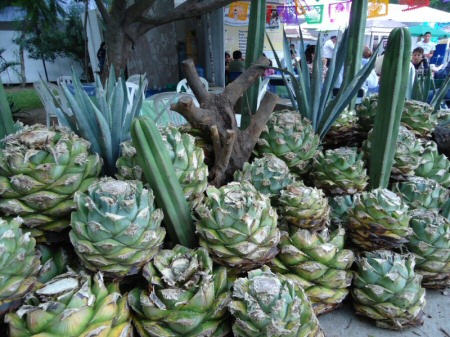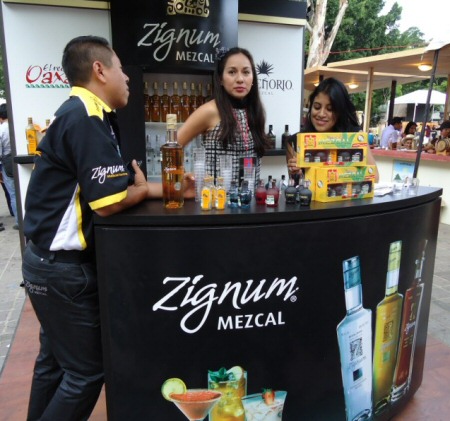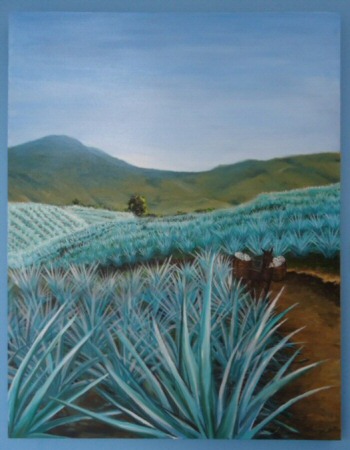
Agave plants with cactus and lots of piñas More Photos
|
 Agave plants with cactus and lots of piñas More Photos
|
The state of Oaxaca has traditionally been known as the largest and most important producer of mezcal (also referred to as mescal) in all Mexico. Santiago Matatlán, a town about 45 minutes outside of the state capital, boasts being the world capital of the spirit. It's home to about 150 palenqueros (mezcal producers). A full size copper still stretches majestically across the highway at its entranceway. And so what better city than Oaxaca to host an annual festival dedicated to exalting and promoting the agave based alcoholic beverage "with the worm."
A Primer on Mezcal in Oaxaca
Over the past several years the worm has actually been part of the problem in legitimizing mezcal as a spirit worthy of sipping and mixing. The other main impediment has been mezcal's lingering reputation with the college crowd as the Mexican spirit used to get inebriated, fast and furiously.
But the world has finally come to learn that mezcal is often as smooth and complex a spirit as fine single malt scotches, and can be consumed as such. The worm, actually a larva known as a gusano, is more often than not absent from both bottle and recipe.
Mezcal in Oaxaca is produced from a number of varieties of agave (often known as maguey), though commercial production utilizes almost exclusively agave espadín. In the preferred, traditional method of production the plant is harvested after 8 - 10 years of growth. Its heart, or piña, is baked in an in-ground oven, and then crushed. [While the leaves are not used in the process, they are nevertheless employed in other industries, thus contributing to the reputation of mezcal as a sustainable industry.] The fibrous mash is fermented for up to two weeks, usually in pine vats with water, and nothing else added. Yeasts are naturally produced in the environment. The fermented liquid is then distilled. Mezcal drips from the spigot, usually ready for consumption after a second distillation.
Hundreds, if not thousands, of small, hillside and village mezcal producers follow the age-old production method. Some families tell a fascinating history of mezcal production dating back centuries. Most researchers and aficionados believe that distillation was introduced into Mexico subsequent to 1519 by the Spanish. However there are studies which suggest that distillation was practiced by indigenous groups.
In addition to these quaint palenques, large industrial multi-million dollar mezcal production factories have come onto the scene over the past 20 years or more. Brands such as Benevá and Zignum exemplify the most commercial mezcal production imaginable. While these facilities also cook, crush, ferment and distill agave, both the means of production and the machinery employed could not be any further removed from the fascinating and often highly ritualistic small-scale production. They are the polar opposite of what one envisions as Slow Food mezcal proponents.
 Zignum is the new rich kid on the block More Photos
|
Feria Nacional del Mezcal in Oaxaca in Historical Context
Initially Mexico's national Feria del Mezcal was a small tasting and promotional exposition. Organizers wisely arranged for it to coincide with the yearly Guelaguetza festivities in Oaxcaca, the last two weeks of July. The Guelaguetza is a celebration of the multiplicity of cultures represented in the state. The mid-summer merriment is filled with unrivalled pageantry and a diversity of dance, costume, music, food and other indicia of the rich cultural traditions for which Oaxaca is known. Hence, at this time of year Oaxaca becomes a Mecca for tourists visiting from all corners of the globe.
In the early years the Feria consisted of small booths set up by individual mezcal producers, each offering free samples of at least a couple of different varieties of the spirit. Most palenqueros employed provocatively clad and well made-up young women to lure prospective purchasers towards their stands; sex sells alcohol as much in Mexico as elsewhere. But it's always been good clean fun and imbibing. However business owners along Calle 5 de Mayo, the street where the kiosks were erected, complained of a little too much rowdiness, especially for the likes of those tourists lodging in nearby higher end hotels.
At the same time that mezcal's star began to rise, organizers started looking for ways to address this concern, and at the same time create an event which would attract a more diverse demographic than previously; both men and women of all ages, residents and tourists alike from a broad range of socio-economic backgrounds.
The venue vacillated between a theater and convention center known as Álvaro Carrillo (too far away from the center of downtown to attract the desired crowds), the north end of Oaxaca's famed pedestrian walkway Macedonio Alcalá (too narrow and restricted in terms of bringing other attractions into the fold), and the largest park in downtown Oaxaca, Paseo Juárez el Llano. In the end, one of its earlier locations, el Llano, won out over the rest. It's an easy walk from most downtown hotels and guest houses, and a 10 - 15 minute drive from the popular north and east Oaxacan suburbs. It would be the fair's permanent home. In 2011, for the first time the event occupied the entire two-city-block park.
While the number of participating producers did not significantly increase over recent years, the variety of product has, with many more cremas (sweet mezcals) than previously, intended to attract more women (arguably an inaccurate stereotype) as well as others who are not regular spirits drinkers. More aged mezcals from different regions were represented, as were herbal infusions and the odd mezcal made from a different variety of agave.
When the Feria was first instituted there was no entrance fee, perhaps contributing to the initial problem. Then a ten peso entry fee was levied in part in an effort to dissuade some attending solely for the purpose of getting free drinks. While it now costs 35 pesos to attend the Feria Nacional del Mezcal, visitors to the festival get much more than their money's worth; the festival now satiates all the senses.
The 14th Annual Feria Nacional del Mezcal in Oaxaca Turns the Corner
Outside the Feria del Mezcal and lining its extensive perimeter was a diversity of booths selling virtually every craft produced in the region: alebrijes; tapetes; embroidered blouses, dresses and huipiles; cotton textiles; jewelry and metalwork; hand-turned clay products ranging from terra cotta utilitarian, to decorative black pottery, to ultra-modern high-fired porcelain pieces. Cuisine countered the urge to shop, with tacos al pastor, tlayudas, carnitas, memelitas and more. From the street, the billowing smoke of firewood fueling comals, the rich aromas, and the sizzling of steak arrachera, drew you near - and then inside.
Oaxaca is of course known for its gastronomic greatness, so within the confines of the feria the theme continued, with a large sit-down restaurant and booths selling and offering samples of prepared moles and salsas. But you'd come for mezcal, and everything associated with it.
A gallery of vintage photos greeted you upon entering: farmers in their fields harvesting agave; traditional roadside facilities; hectare upon hectare of maguey photographed at sundown, at daybreak, in the sun and with shadows. Next there was the media area where passersby were asked if they could be interviewed for TV and radio concerning their thoughts about mezcal and the fair, as well as tourism in Oaxaca.
 Agave art More Photos
|
The grounds were landscaped with outcrops of cactus, agave and other succulents. An enormous 3D screen provided the illusion of an expansive field under cultivation, in front of which were real agave, and the tools of the trade; implements, a multi-ton limestone wheel used to crush the baked agave, and a pine vat employed to ferment. Visitors stopped to take photos of their friends and lovers posing as if an actual part of the scene. The massive band shell and stage was host to amateurs vying for prizes for singing, strumming an instrument or telling a story. Local bands played from time to time. Nationally renowned singers and musical groups were given top billing for special evenings: Pablo Montero, María José, Sonora Dinamita, Apuesta and Julion Alvarez. This of course had nothing to do with mezcal, but attracted youth and others who wanted to hear, or just catch a glimpse. And it succeeded, as throngs queued up waiting to enter the fair to see their idols on those dates noted on posters and flyers.
But most came to be enticed to saunter up to one makeshift bar as opposed to the next, to sample a blanco, a reposado or an añejo; or perhaps an agave tobalá; or even one of a number of cremas, a rainbow of pastel colored mezcals. There was mezcal for every budget, and for those wanting to spend even more, 1800 pesos for mezcal in a hand-blown glass bottle with a delicate glass sculpture encased inside.
Most of the big players were represented, such as stalwart Oro de Oaxaca, several producers from the Chagoya family, and the new rich kid on the block, Zignum. But small palenqueros from outlying villages hours away from Oaxaca, far beyond Matatlán, also came to ply their product. They brought their wives and daughters down from the hills to help, rather than agency hires with simulated smiles, properly poised with sashes over skimpy costumes. Fourteen years after the inaugural Feria Nacional del Mezcal, glamor and glitz still mattered and were a significant draw. According to the Minster of Tourism, this year the fair hosted a remarkable 48,000 visitors.
Well After the Feria, Mezcal Marches On
But moving forward from 2011 it's actually the Plain Janes of mezcal which will be the spirit's best ambassadors, the mezcals made from wild and lesser known varieties of agave, with different flavors and nuances. Hopefully they'll be represented much more at the Feria in years to come. Yes, mezcal still needs its commercial producers, if for no other reason that to use their big budgets to pique consumer interest by providing basic education - there's much more to mezcal than the worm. The public is becoming much more sophisticated. As the decade proceeds, aficionados of fine spirits will start to put the Glenmorangies and the Lagavulins back on the shelf, and pick up a bottle of quality mezcal.
Alvin Starkman is a paid contributing writer for Mexico Today, a program for Marca País - Imagen de México. An aficionado of agave-based beverages, he takes couples and families into the hills to sample mezcal made by only traditional producers, and into the fields to participate in the harvesting of aguamiel, for fermenting pulque. Alvin has written over 200 articles about life and cultural traditions in Oaxaca, consults to documentary film companies, and with his wife operates Casa Machaya Oaxaca Bed & Breakfast.